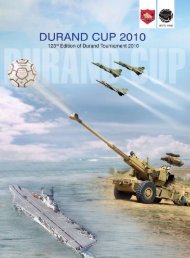Shimla-the birthplace of the Durand Cup and the Indian Air Force ...
Shimla-the birthplace of the Durand Cup and the Indian Air Force ...
Shimla-the birthplace of the Durand Cup and the Indian Air Force ...
Create successful ePaper yourself
Turn your PDF publications into a flip-book with our unique Google optimized e-Paper software.
heroes<br />
The memorable Gorkha Brigade<br />
By Novy Kapadia<br />
In 1996, <strong>the</strong> Gorkha Brigade lost in <strong>the</strong> first round <strong>of</strong> <strong>the</strong><br />
pre-<strong>Dur<strong>and</strong></strong> tournament 0-1 to <strong>the</strong> local league runners<br />
up Hindustan F.C. On <strong>the</strong>ir way to <strong>the</strong>ir first ever <strong>Dur<strong>and</strong></strong><br />
triumph (Shyam Thapa’s exploits enabled <strong>the</strong>m win once<br />
again in 1969), Gorkha Brigade beat Leaders Club, Jal<strong>and</strong>har<br />
4-1, Rajasthan Armed Constabulary (RAC) Bikaner <strong>of</strong> Magan<br />
Singh fame, 0-0 <strong>and</strong> 8-0, former champions Mohammedan<br />
Sporting 4-0 in <strong>the</strong> quarter finals, holders Mohun Bagan 2-0 in<br />
<strong>the</strong> semi final <strong>and</strong> <strong>the</strong> mighty Sikh Regimental Centre (SRC) 2-0<br />
in <strong>the</strong> final to win <strong>the</strong> <strong>Dur<strong>and</strong></strong> tournament, with an enthralling<br />
display <strong>of</strong> speedy, attacking football.<br />
In <strong>the</strong> last decade <strong>of</strong> <strong>the</strong> 20th century, <strong>the</strong> once mighty Gorkhas<br />
were a pale shadow <strong>of</strong> <strong>the</strong>ir all conquering unit <strong>of</strong> years ago.<br />
The decline was an apt reflection <strong>of</strong> changing values in society<br />
<strong>and</strong> receding interest in regimental sports. In <strong>the</strong> 1966 <strong>Dur<strong>and</strong></strong><br />
tournament, three <strong>of</strong> <strong>the</strong> semi finalists were regimental teams<br />
from <strong>the</strong> Services, Gorkha Brigade, SRC <strong>and</strong> EME Secundrabad.<br />
Bagan was <strong>the</strong> only civilian side in <strong>the</strong> last four <strong>of</strong> <strong>the</strong> <strong>Dur<strong>and</strong></strong><br />
tournament.<br />
Gorkha’s owed <strong>the</strong>ir 1966 triumph to <strong>the</strong>ir brilliant quintet<br />
<strong>of</strong> forwards, outside right Rawat, inside right Ranjit Thapa,<br />
nippy centre forward<br />
Bhupinder Singh Rawat,<br />
dapper, diminutive<br />
inside left Tika Ram<br />
Gurung <strong>and</strong> wily left<br />
winger Amar Bahadur,<br />
Their skill, speed, thrust<br />
<strong>and</strong> goal scoring abilities<br />
were a source <strong>of</strong> wonder<br />
<strong>and</strong> delight. They<br />
were ably supported<br />
by indefatigable Nar<br />
Singh as left half.<br />
The Gorkhas played<br />
in <strong>the</strong> old fashioned<br />
3-2-5 formation,<br />
three defenders, two<br />
midfielders <strong>and</strong> five<br />
forwards. However,<br />
Ranjit Thapa <strong>and</strong> Tika<br />
Footballer Bhupender Rawat Ram’s versatility <strong>and</strong><br />
Chima Okorie greets Shyam Thapa<br />
work rate enabled <strong>the</strong>m to backpedal <strong>and</strong> bolster midfield<br />
when under pressure as well as initiate speedy counter attacks,<br />
with deft throughs. So though Gorkha Brigade started in a<br />
3-5-2 formation, <strong>the</strong>y frequently functioned in a 3-3-4 or 3-4-3<br />
formation.<br />
Short-statured Bhupinder Rawat, nicknamed ‘Scooter’ for<br />
his blistering speed <strong>and</strong> quickness <strong>of</strong>f <strong>the</strong> mark was an ideal<br />
poacher <strong>of</strong> goals. He would hover around <strong>the</strong> goal area, drift<br />
into vacant space, when <strong>the</strong> inside forwards fell deep <strong>and</strong><br />
use his speed to brcak through <strong>and</strong> score with placements or<br />
diving headers from measured crosses by Amar Bahadur. With<br />
his speed <strong>and</strong> instinct for goal, Rawat was like a poor man’s<br />
Paolo Rossi. Amar Bahadur was all silky skills on <strong>the</strong> left flank.<br />
His repertoire <strong>of</strong> dribbling skills drew gasps <strong>of</strong> admiration. He<br />
was not an old fashioned left winger but could cut in <strong>and</strong> score<br />
goals. Above all <strong>the</strong> five forwards gelled perfectly as a cohesive<br />
unit. Of this famous five, four were snapped up by Mafatlal<br />
Mills, Bombay. Amar Bahadur joined in 1967 <strong>and</strong> Bhupinder<br />
Rawat, Ranjit <strong>and</strong> Tika Ram a year earlier. Only right winger<br />
Rawat retired with <strong>the</strong> Gorkha Brigade. Subsequently, Tika<br />
Ram ran a provision store in Dehra Dun, Amar Bahadur looked<br />
after a family hotel in <strong>the</strong> outskirts <strong>of</strong> Bombay <strong>and</strong> Bhupinder<br />
Rawat joined an administrative post with Sports Authority<br />
<strong>of</strong> India (SAI). Only Ranjit Thapa maintained some link with<br />
purple beret July 2011 21



